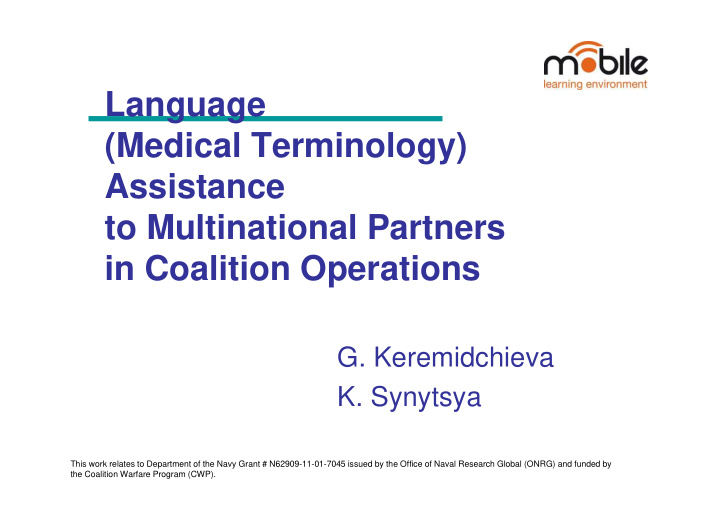



Language (Medical Terminology) Assistance to Multinational Partners in Coalition Operations G. Keremidchieva K. Synytsya This work relates to Department of the Navy Grant # N62909-11-01-7045 issued by the Office of Naval Research Global (ONRG) and funded by the Coalition Warfare Program (CWP).
Context: MoLE • Multinational partners in MSO • Proof of concept, 22 nations, US- sponsored • Use of handheld devices to support m- learning and m-collaboration • Wireless connectivity, smartphones
Research Background • Use of mobile devices is increasing world- wide for internet access, learning, performance support • Medical emergencies require communication in English • Pilot studies in language learning focus mostly on students • Direct conversion of courses to mobile format may be not the best idea
Research Objectives • Identify needs in medical terminology assistance or language enhancement • Research and evaluate methods used for language learning and assistance with a focus on mobile devices • Make recommendations on refinement of selected methods to enhance support of coalition operations
Needs Analysis
Participants • Albania, • Brazil, • Bulgaria, • Canada, • Germany, • Hungary, • Poland, • Romania, • Slovakia, • Slovenia, • Switzerland, • Turkey, • Ukraine, • USA
Emergency situations
Learning needs • Body parts • Injuries • Pain • Illness symptoms • First aid devices • First aid activities • Communication patterns
Scenarios with pictures Bites chemicals etc This work relates to Department of the Navy Grant # N62909-11-01-7045 issued by the Office of Naval Research Global (ONRG) and funded by the Coalition Warfare Program (CWP).
M-readiness • Use of mobile devices is a good idea • Opinions are based on individual experience • GPS, data exchange (pictures and video) • Saving and entering data in emergency forms • Should be easy to use
M-learning: definitions • “…elearning through mobile computational devices” [ C. Quinn, 2000 ] • “any educational provision where the sole or dominant technologies are handheld or palmtop devices” [ J.Traxler, 2005 ] • “…the use of handheld computing devices to provide access to learning content and information resources” [ Mobile ADL, 2011 ] • “learning in context” [ G.Woodill, 2011 ]
This work relates to Department of the Navy Grant # N62909-11-01-7045 issued by the Office of Naval Research Global (ONRG) and funded by the Coalition Warfare Program (CWP).
Expectations of m-users • Personal use -> individual service • Any time, any place -> instant help (touch-away) • Quick & easy • Assistant, not a boss
Language assistance now and then • Learn critical terminology • Master communication patterns • Refresh language skills • Get access to an online dictionary • Role play and situation planner • Connect to translation service
LEARNING VS. REFRESHMENT Are all technologies and strategies the same? This work relates to Department of the Navy Grant # N62909-11-01-7045 issued by the Office of Naval Research Global (ONRG) and funded by the Coalition Warfare Program (CWP).
MALL recommendations • Audio & video (podcasting) • Text as an anchor & on-demand • Context-based mini-vocabulary • Small learning objects • On-line/off-line provisions • Translation to native language • “My dictionary”: customization by a learner • Refreshing: simple user modeling
Conclusion • Design for mobile natives -> augmented human in augmented reality • Technical limitations: now, in 5 years? H. Maurer, WEBIST 2010 / CSEDU 2010 “How much technology?” (invited talk) • Reusability of content (collections) • Support natural learning
Table of Contents (March-Sept) • Introduction • Background and History • Overview • Research Objectives • Mobile Learning: Definition • M-learning vs. E-learning • Methodology • Conclusion • References
Table of Contents (Oct-March) • Introduction • Technology-enhanced language learning • Background and History – Vocabulary learning • Overview – CALL&MALL • Research Objectives – Efficiency issues • Mobile Learning: • Proposal definition – Strategies & samples • M-learning vs. E-learning – Architecture • < Distinctive features > • Conclusions (new) • Methodology • References (added) • < Content gaps >
Recommend
More recommend